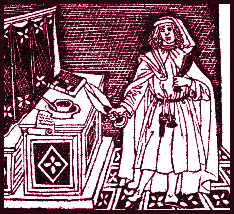
Presteigne
Wealth from wool
A prosperous time
After the terrible devastation of the plague epidemics of the
second half of the 14th century, Presteigne saw an improvement
in its fortunes during the course of the following century, chiefly
due to the wool trade.
The region around the town and particularly the upper Lugg valley,
was noted for the quality of its wool, and there was a period
of expansion of the industry, including a significant amount of cloth manufacture in the town.
amount of cloth manufacture in the town.
The cloth industry in and around Presteigne was carried out on
a considerable scale in the early 1500's, almost certainly helped
by the closeness of the town to Ludlow, an important regional
centre of the cloth trade. The level of production of cloth by
this time appears to have been greater than that required by
purely local markets.
There is evidence that skilled craftsmen from Flanders were present in the town around 1550, possibly being involved in the training of local workers in the techniques of what had become an important trade for the prosperity of the town.
The rise of John Beddoes
Important figures associated with the cloth industry of the town
around this time were the Bradshaws, a merchant family who came
from Ludlow, and John Beddoes, who also had Ludlow connections.
He was first recorded in Presteigne in 1535 as a weaver, but
was later to acquire considerable wealth and status as a cloth
merchant, and through his transactions in property and land.
At the time of his death he owned land in twenty parishes, and he is best known for his generous endownment of a free grammar school for the town of Presteigne. The cloth industry, however, was to suffer grievously from the return of plague epidemics, particularly that of 1636-37. These brought about the loss of skilled craftworkers and destroyed the confidence of the former buyers.